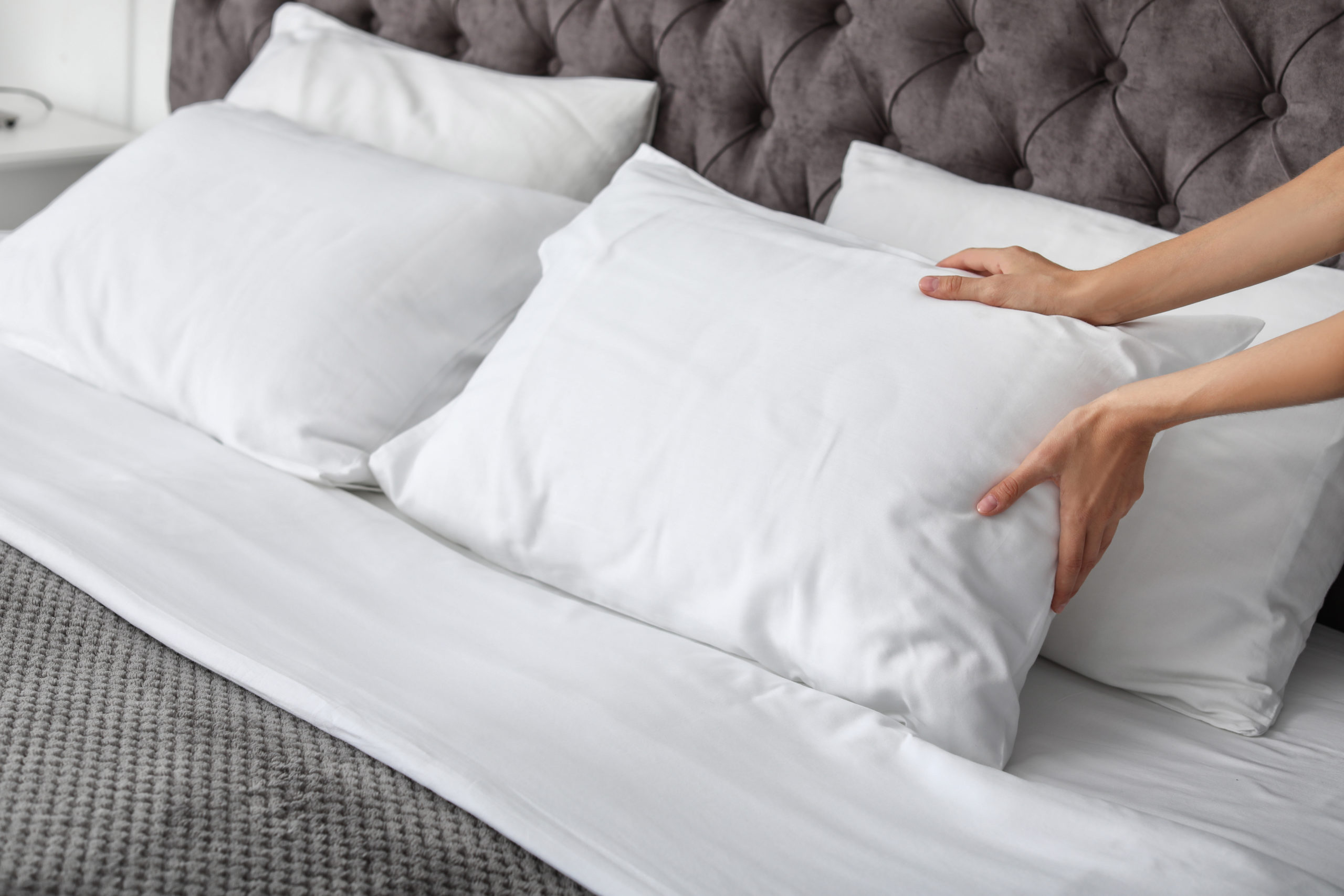Author: Carrie Beach
Tips to Keep Your Towels Softer Longer
How to Soften Towels.
Everyone loves a soft, absorbent towel. But even after buying the most soft and plush towels, they can end up feeling scratchy & stiff after a few months? Why?
It has to do with how they’re washed (and dried). Every towel will get this way if body soil, oils, detergents, chemicals, and minerals are left in the fibers after washing. Most of the time, the softness can be brought back by following some easy steps:
- Increase the water temperature – warm or hot water will produce best results.
- Don’t overload your washer.
- Replace fabric softeners with distilled white vinegar – this will combat the residue that reduces absorbency
- Use wool dryer balls and a lower heat setting – this keeps towels fluffy.
Three Reasons to Wash Your Sheets Weekly
Wash Sheets Weekly – Here’s Why.
Studies show that washing your sheets weekly can lead to better sleep. And if that isn’t enough. Here are three more reasons why:
- You shed thousands of skin cells when you sleep – and dust mites love to feed off dead skin.
- You sweat while sleeping – and body soils transfer to your sheets.
- You drool at night – when you’re sleeping your swallowing reflexes relax which can allow saliva to escape from your mouth.
There’s a lot more to washing your sheets than just having that comfy, clean bed feeling. You can reduce the build-up of dirt, skin, sweat & oils with weekly sheet washing.
The Best Temperature for Your Laundry
Hot, Warm or Cold – Here’s What Settings to Select & Why.
Choosing the best water temperature for your laundry doesn’t have to be a mystery. Before you get started, CSC recommends to:
Read Garment Care Labels – this will give you the info you need to choose the best water temperature and right type of wash cycle.
Sort Dirty Laundry – after you’ve checked the labels, sort your laundry by color, fabric type and washing temperature.
Choose Cold Water if in Doubt – if a label is missing or unclear, wash clothes (especially if colored) in cold water. This will prevent any damage to fabric such as shrinking, fading or color bleeding.
Once ready, here are the wash settings CSC recommends.
Hot Water
- Best used for white cotton clothes, bed & kitchen linens, bath towels, soiled, stained or sweaty garments.
- Cleans heavy soils and stains, sanitizes linens
- Can fade colors or shrink if the wrong items
Warm Water
- Best used for man-made fabrics like nylon, polyester, spandex, rayon, fabric blends and lightly soiled clothes.
- Helps to dissolve detergents and offers more energy efficiency than hot water.
- Can fade some colors, does not sanitize, will not remove heavy soils and stains
Cold Water
- Best used for bright-colored clothes and delicate fabrics
- Most energy efficient and less likely to shrink or fade items
- Can be used on any fabric, but less efficient in removing stains
Kitchen Essentials to Wash More Often
Did you know you could wash these kitchen items?
You know it’s best to wash your kitchen towels (for dishes and hands) daily, but did you know that these other kitchen items should also be washed regularly.
Silicone baking mats & molds – toss in with regular laundry and put small items in a mesh laundry bag. Make sure to air dry.
Oven mitts & hot pads – wash and dry along with your kitchen towels
Small Kitchen Rugs – be sure to shake out in advance of washing, wash separately, and dry on low heat.
Mop heads, sponges & rubber gloves – remove from handles and place in mesh laundry bag with a load of towels. Dry completely before storing.
How to be a Good (Laundry) Citizen
The Do’s and Don’ts of Shared laundry rooms.
It’s always important to be a good neighbor, and that applies to sharing a community laundry room too. Here are some tips to ensure an enjoyable laundry experience for everyone.
Don’t forget to remove your laundry quickly – emptying machines helps others get started, and helps you avoid having your laundry handled by others. Your CSC laundry app alerts you when your laundry is done.
Do leave the laundry room the way you’d like to find it on your next visit – make sure to clean out the lint trap, throw away trash, and wipe down the washer if needed.
Don’t assume a broken machine has been reported – submit a service request directly from your laundry app by noting the location and machine number.
Do drop laundry pods into the washer with your clothes – not the detergent drawer. Otherwise, the degradable wrap doesn’t fully dissolve and can clog the detergent drawer for others.
Closet Items to Wash Every Season
Don’t forget to wash what’s in your closets.
It’s easy to forget to care for items we keep in our closets, but things like jackets, bags & sports gear need regular washing to keep them looking good. CSC recommends washing these items with the change of every season, or more often as needed.
Jackets: be sure to check washing & drying instructions beforehand.
Sports Gear: shin guards, knee pads, compression sleeves & yoga mats
Backpacks & Duffel Bags: fabric & vinyl ones can be tossed in the washer with a regular load of similar colored laundry
Soft-Sided Lunch Bags & Boxes: have potential to be contaminated with bacteria from the foods inside and need to be washed regularly.
Reusable Grocery Bags: especially those used for produce & meats should be washed after every use.
Bedroom Essentials to Wash More Often
When was the last time you washed them?
Studies show that washing sheets weekly can lead to better sleep – and we all know there’s nothing better than crawling into bed with clean ones. But what about clean pillows, mattress pads, blankets & comforters – when was the last time you washed them.
Just a few tips before you get to washing.
- Feather or polyester-filled bed towels & mattress pads can be tossed in the washing machines – foam ones cannot.
- Make sure to give pillows, pads & comforters room to move, and don’t overfill the washer.
- Follow instructions on tags for heat or air drying.
How To Keep Your Clothes Looking New
Tips for making your clothes look like new
1. Reduce the amount of detergent you use in the washing machine.
More doesn’t always mean better, especially when it comes to laundry detergent. Too much detergent can leave a powdery residue or dull sheen on your clothes. Best to use the very minimum recommended for your washing machine or, better yet, use detergent pods.
2. Keep pet hair in check.
If you have a cat or a dog in your home, you have pet hair on your clothes. However, too much pet hair can damage the fibers in your clothing and cause them to break down—a good reason to keep on top of brushing pet hair from your clothes or removing it with tape.
3. Wash dark clothing inside out.
Another tip for keeping your clothes looking newer longer is to wash your dark clothing inside out. This way the dye in the clothing will run onto the other side of the piece rather than washing down the drain.
4. Wash your clothes a second time without soap
Running your clothes through the wash cycle a second time without the soap will help get rid of any residual detergent and help your clothes last longer. You’ll be amazed at how much soap is still in the drum during this second “wash.”
How To Get Grease Stains Out Of Clothes
But don’t lose heart – your favorite shirt doesn’t need to be relegated to house-wearing only. Just follow these easy steps to eliminate those unseemly grease stains in no time!
The key: Dish soap
Out of all the cleaning and specially-designed stain-removing products on supermarket shelves, the thing that fights grease stains the best is common dish soap! Though you might be skeptical that something so ordinary could work on an extraordinarily difficult stain, trust us – it has a great chance of working. If you think about it, it isn’t so far-fetched; after all, dish detergent is designed to break down food and oils to keep your dishes clean, so why shouldn’t it also work on clothes?
Step 1: Get petroleum-based dish soap
These soaps work best for grease stains, so if you only use natural dish detergents, you will want to run to the store to get something like Dawn.
Step 2: Test it out
Though you shouldn’t have any trouble, it is best to test out your soap first to make sure it won’t discolor the fabric. Some have suggested selecting clear dish soaps, since you may have a color problem with blue or green detergents.
Step 3: Apply to stain
Rub in your dish soap on the stain, scrubbing hard, and let it sit for several minutes.
Step 4: Toss in the washer
The item is now ready to go in the washer. But, if your soap makes a lot of suds, you will want to rinse out the majority of the dish soap to protect your washing machine.
Step 5: Check before placing in dryer
After the cycle is over, pull out the item of clothing to see if the stain is gone. If not, repeat this process until you don’t see the grease. If it is especially persistent, soak the clothes for up to an hour after step 3 before throwing them back in the washer.










